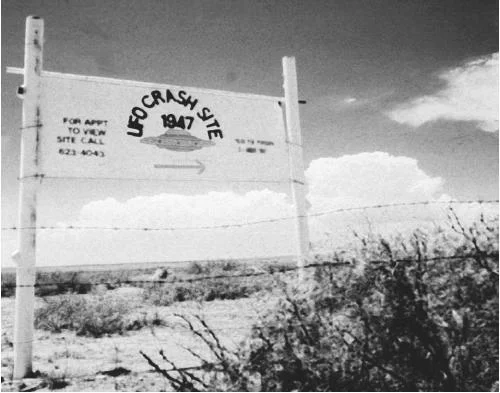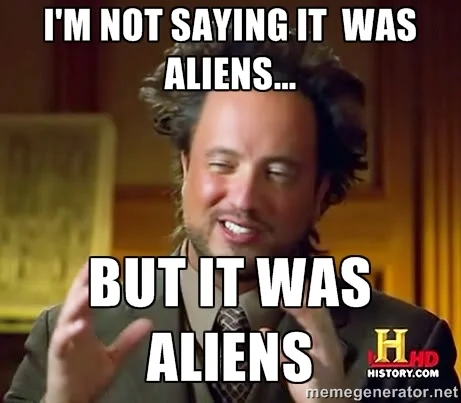It's Pronounced /Yoo'fälejee/
/Hobbyists, conspiracy theorists, and a handful of earnest scientists have studied the phenomenon of Unidentified Flying Objects since the end of World War II, but it wasn’t until about 1980 that they began to fixate on a mysterious crash outside the small town of Roswell, New Mexico, back in the summer of 1947. Some say a flying saucer or two was taken down by a lightning storm, killing half a dozen aliens aboard but leaving two little gray men alive to be secreted away for government studies. Others offer a slightly more plausible explanation: a high-tech hovering Soviet spycraft crashed while conducting Cold War military reconnaissance around White Sands Missile Range and Sandia Base.
Those who take the alien-based explanations seriously and commit themselves to studying extraterrestrial sightings call their field ufology (pronounced—yep—/yo͞oˈfäləjē/). But, as this blog proves, adding the suffix “-ology” does not render one’s area of interest a legitimate science. Broadly speaking, ufology has long been dismissed as a pseudoscience or, at best, a fringe area of research. There’s just too much emphasis on hearsay and conjecture and not enough on evidence or testable hypotheses. As James Oberg wrote in New Scientist magazine just when ufology was beginning to gain traction in the public consciousness in 1979: “It is clearly not logical to base the existence of a positive (‘true UFOs exist’) on the grounds of a hypothetical negative (‘no matter what the effort, some UFO reports cannot be explained’). This latter fallacy can be called the ‘residue fallacy,’ and it has been addressed by philosophers of science numerous times in the past.”
In the case of Roswell in particular, the out-of-this-world witness accounts are old, muddled, and contradictory, and any pro-alien evidence cited is scant and circumstantial. While it would be fascinating to explore how elaborate, far-fetched conspiracy theories originate and why people adhere to them, I’ll leave that work to others and turn instead to what’s known about this particular case. What really went down outside Roswell?
What happened in Roswell?
In 1947 reports of flying saucer sightings weren’t uncommon and the public was predisposed to believe in the fantastic. Just a decade earlier a large swath of the population had descended into hysteria because they believed Martians were invading thanks to the fictional radio play War of the Worlds. In the intervening years technology had advanced by leaps and bounds, drawing citizens out of the down-and-dirty Depression and Dust Bowl era with such previously inconceivable capabilities as radar, jet engines, and nuclear weapons. Anything seemed possible, and paranoia about enemy surveillance and sneak attacks was potent in a nation transitioning from a World War to a Cold War.
The Roswell Daily Record announced the capture of a flying saucer on July 8, 1947
It was in this context that a rancher by the name of Mac Brazel announced that he had discovered mysterious debris scattered in a field northwest of Roswell. The local police brought in the Air Force to investigate. As the Roswell Daily Record reported on July 8, Brazel and other citizens in town believed it to be the detritus of an alien flying saucer.
The Air Force, in contrast, concluded that the materials were merely remnants of a downed weather balloon. As the same paper clarified the following day, “An examination by the army revealed last night that mysterious objects found on a lonely New Mexico ranch was a harmless high-altitude weather balloon—not a grounded flying disk. Excitement was high until Brig. Gen. Roger M. Ramey, commander of the Eighth air forces with headquarters here cleared up the mystery.”
This explanation made sense, since the debris consisted of rubbery strips, sticks, metallic foil, and pastel tape marked with odd flowery symbols—hardly the slick construction you might expect of a capsule capable of traversing continents, let alone the vacuum of space. The public generally accepted the explanation, and no one paid much attention to Roswell for the next thirty years.
Then in 1978 the nuclear physicist Stanton T. Friedman renewed interest in the crash by conducting new eye-witness interviews and publishing new theories. He and soon his followers claimed that Brazel had discovered a downed saucer and the Air Force’s weather balloon explanation was a cover story to conceal the truth from the public: extraterrestrials had visited Earth and their ship—maybe even their bodies—were now in government custody. Ever-wilder iterations of the conspiracy theory spiraled off in many directions over the following years as investigations, interviews, books, and documentaries multiplied. The air was thick with suspicion, drama, and media dollars.
So was there a coverup?
The most likely explanation of what happened that fateful day outside Roswell: Some research balloons blew off course, lost contact with scientists on the ground, and eventually crashed back into the same planet (and country) from which they launched some hours earlier.
These photos from July 9, 1947, show Brig. Gen. Roger M. Ramey, commanding general of 8th Air Force, and Col. Thomas J. Dubose, 8th Air Force chief of staff, identifying the debris found near Roswell as pieces from a weather balloon
But even if the debris was just from a balloon, there may still have been a government coverup. That is, the balloons might not have been a benign weather device, as claimed, but rather part of a top-secret military surveillance research program called Project Mogul.
Project Mogul’s goal was to design balloons that could hover stably in an acoustic “duct” between the troposphere and the stratosphere. The particular acoustic properties of the air layer at that altitude were discovered following analysis of the sound waves produced by Krakatoa’s 1883 volcanic eruption. Now researchers hoped that floating microphones at this altitude would capture sound waves that echoed from nuclear test sites halfway around the world in the U.S.S.R., allowing the U.S. military to monitor the Soviet nuclear program long-distance.
In June and early July of 1947, scientists launched multiple balloons trains from the Alamogordo Army Air Field in southern New Mexico. One Project Mogul scientist, Charles B. Moore, notes that the materials used in Flight 4 that June closely resemble those documented at Roswell several weeks later. Flight 4 was tracked until its batteries died and researchers lost contact. At that point it had traveled several dozen miles to Arabela, just 17 miles from the crash site.
Brazel’s debris and Project Mogul’s Flight 4 balloons shared many features. Both used eyelets for attaching components and reinforcing tape with flowery decorative markings. The radar targets brought from NYU were relatively distinct and unlike other weather balloons flown in New Mexico, so the fact that photos of the Roswell debris show objects resembling these radar targets makes it unlikely that they were staged with local weather balloons for the purpose of a cover-up. Aluminum rings found at the scene also correspond to those used to launch the Project Mogul balloons and hold sonobuoys, and a black box may have been the acoustic equipment’s battery pack.
Furthermore, the wind patterns for that region at that time of year correspond to what would have been Flight 4’s path from Alamogordo to the Foster Ranch. In total the balloons would’ve flown about 85 miles and crashed at a southwest-to-northeast angle, which is indeed how the debris was found.
While Project Mogul was classified for many years due to the sensitivity of its applications in espionage, the public’s renewed interest in ufology and the flurry of media attention given to Roswell in the 1980s and 90s prompted the Air Force to release reports addressing the matter. In 1994 the United States Secretary of the Air Force publicly acknowledged that the debris recovered at Roswell was most likely from a Project Mogul balloon experiment.
In conclusion...
So much time has passed since the crash at Roswell that we’ll probably never prove definitively what happened. Someone somewhere knows or knew what crashed at Roswell, and certain theories and documents are far more believable than others, but how can the public be confident of the information they have when so much classified information and government power is involved? If you’re interested in exploring the question further, there are plenty of books basing all sorts of claims on (supposed) witness interviews, (supposed) photos and film footage from the time, and (supposed) classified or declassified files. Proceed with caution.
Personally, I’m skeptical of claims that a Soviet craft flew 4,000 miles along the west coast into New Mexico only to be downed by lightning over a ranch. I’m even more skeptical that a flying saucer flew 39 light years from the Zeta Reticuli star system only to be downed by lightning over a ranch.
But maybe I’m wrong; maybe there were hostile gray extraterrestrials taken into government custody at Roswell like we saw in Independence Day, or lost little green men just trying to get back to Deep Space Nine. Unlike actual science, when it comes to pseudoscience everyone’s entitled to an opinion.
This post was brought to you by the Committee for Skeptical Inquiry, Annie Jacobsen’s fascinating reportage on Cold War black operations, and a good David Bowie mix to set the mood.




